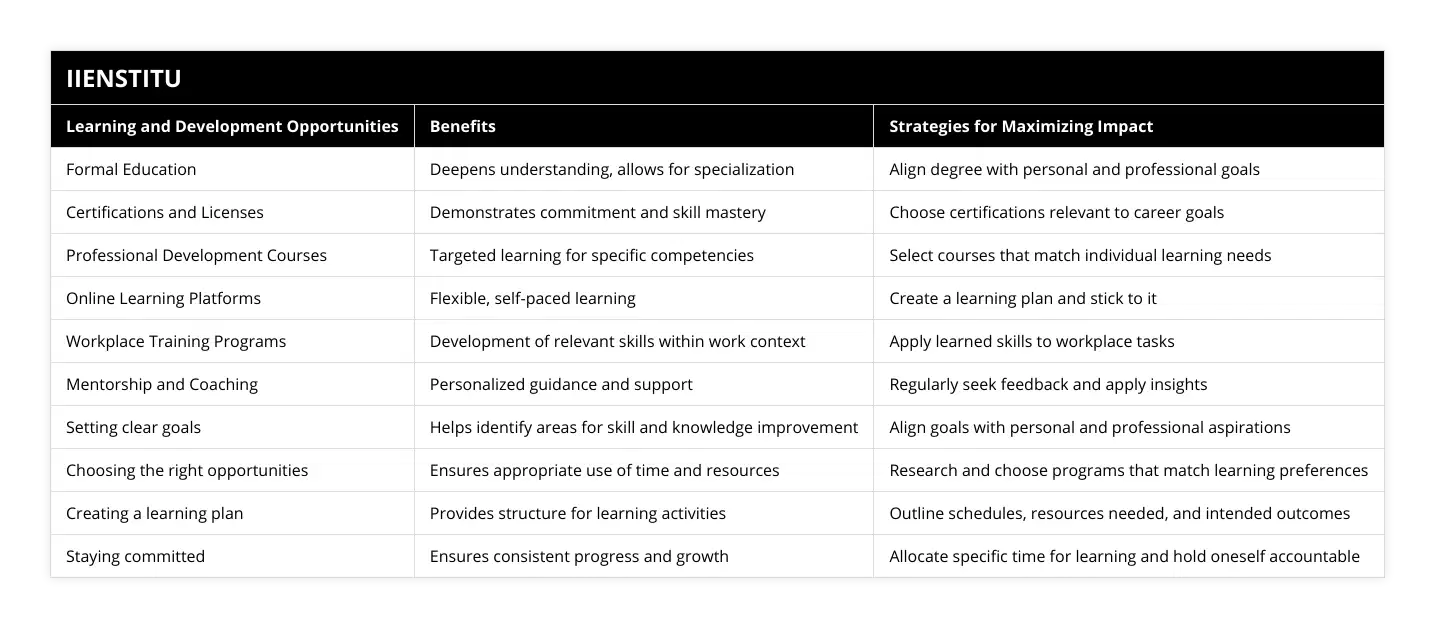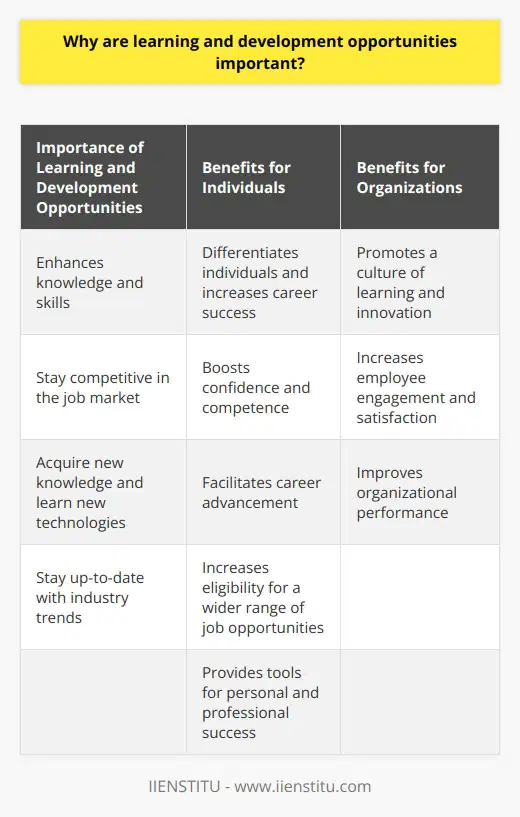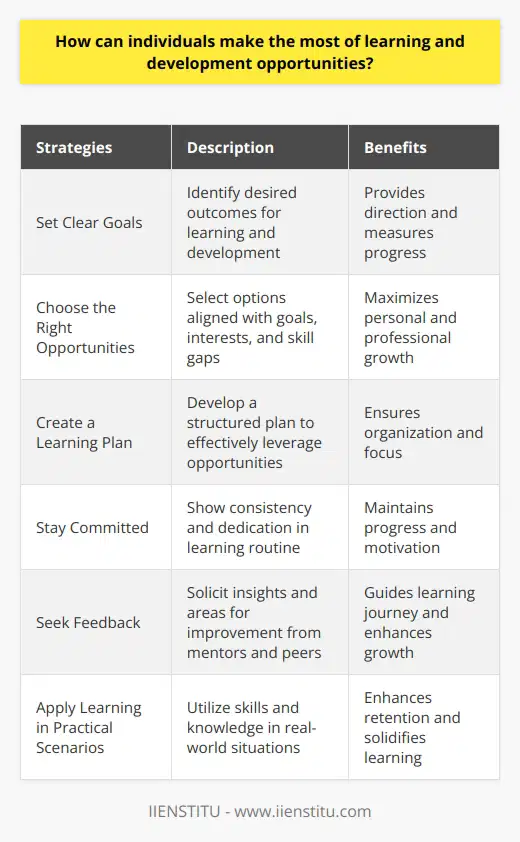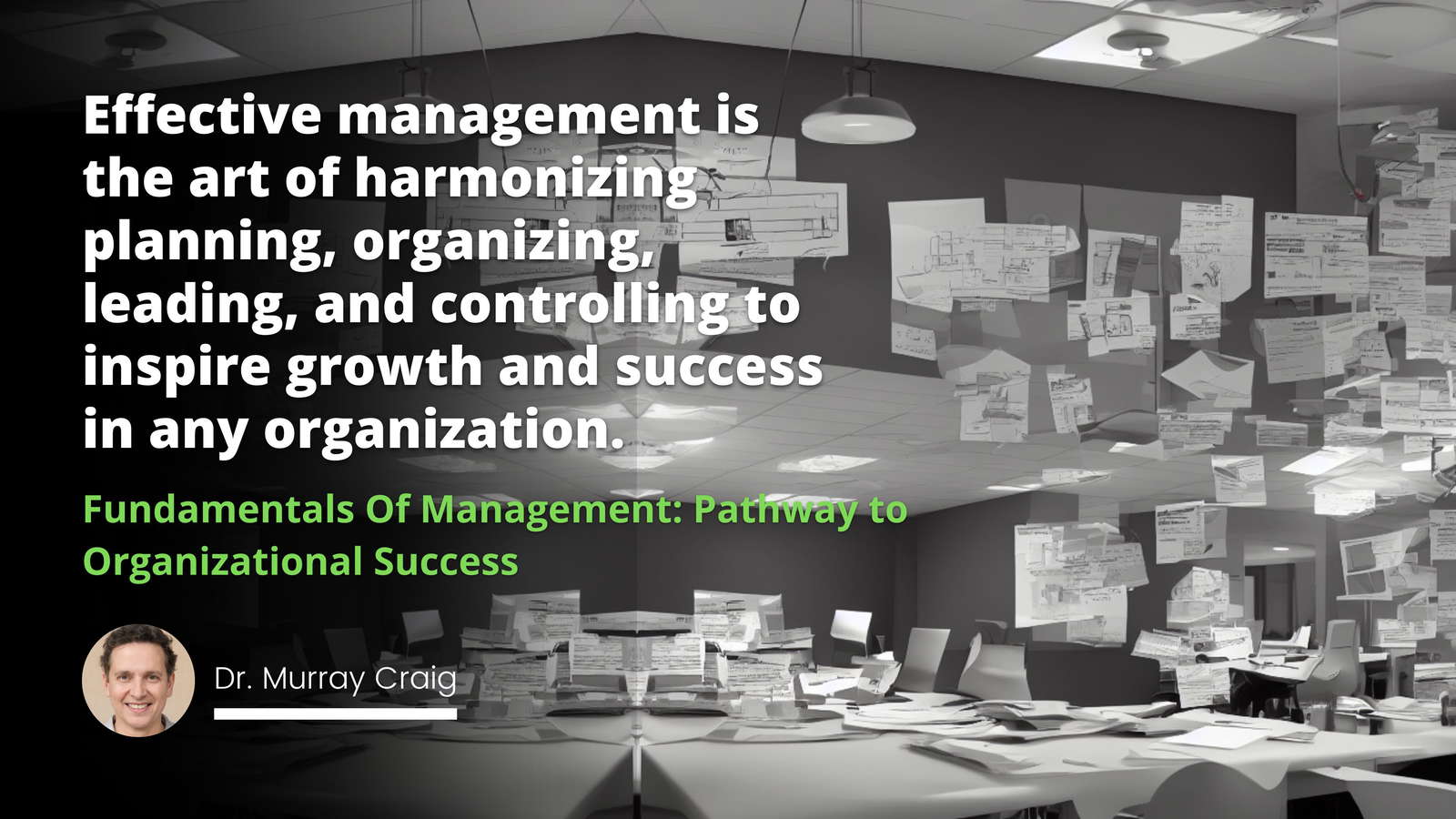
In today's hustle and bustle, I often find myself reminiscing about a time when learning was just confined to the four walls of a classroom. But as I've journeyed through my career, I've realized that the world itself is the biggest classroom of all. You see, the way things are changing—with technology advancing faster than we can keep up, and job markets evolving in unexpected ways—it's become clear that continuous professional development isn't just a fancy term; it's a necessity.
Most Searched Keyword For Principles Of Management İn Business Success
How Do Peers Perceive Your Problem-solving Skills İn An İnterview
The Dawn of Continuous Learning
Enhancing knowledge and skills: By participating in learning programs, individuals can acquire new knowledge and develop competencies to excel in their roles.
Staying competitive: Continuous learning enables professionals to keep up with industry trends and remain relevant in a dynamic job market.
Boosting confidence: Developing new skills and knowledge can increase an individual's self-confidence, enabling them to perform better and contribute more effectively to their organization.
Facilitating career advancement: Continuous learning can lead to promotions, increased responsibility, and higher salaries.
Fostering a culture of learning: Organizations that prioritize learning and development create an environment that supports growth, innovation, and collaboration.
I remember chatting with an old colleague over coffee a few months back. We were discussing how our roles had transformed over the years. She laughed and said, "Back in the day, I never thought I'd need to learn about agile methodologies or concepts like A3 problem solving in agile methodology implementation examples. But here we are!" Her sentiment echoed a larger truth—that to stay relevant, we must embrace learning at every turn.
Formal Education: Pursuing higher education, such as a master's or doctoral degree, allows individuals to deepen their understanding of a subject and gain specialized knowledge.
Certifications and Licenses: Acquiring certifications or licenses demonstrates an individual's commitment to professional development and mastery of specific skills.
Professional Development Courses: Short-term courses, workshops, and seminars provide targeted learning opportunities to enhance specific skills or competencies.
Online Learning Platforms: E-learning platforms offer flexible, self-paced learning options, enabling individuals to access courses and educational resources from anywhere, at any time.
Workplace Training Programs: Many organizations provide in-house training programs to help employees develop relevant skills and competencies.
Mentorship and Coaching: Engaging with mentors and coaches can offer personalized guidance, support, and insights to help individuals navigate their professional journey.
Set clear goals: Identify specific skills and knowledge areas to target for improvement and align them with personal and professional goals.
Choose the right opportunities: Research and select learning programs that best match individual needs, goals, and learning preferences.
Create a learning plan: Develop a structured plan that outlines the learning activities, resources, and timelines needed to achieve desired outcomes.
Stay committed: Allocate dedicated time for learning and development, and hold yourself accountable for progress.
Seek feedback: Regularly solicit feedback from peers, supervisors, and mentors to assess progress and identify areas for improvement.
Apply to learn: Practice newly acquired skills and knowledge to reinforce learning and demonstrate growth.
Why Learning and Development Opportunities Truly Matter
Enhancing Knowledge and Skills
Think about it: when was the last time you learned something new that genuinely excited you? For me, it was when I dived into a course on data analytics. At first, the numbers and graphs seemed daunting. But as I got the hang of it, I found a new passion. Acquiring new knowledge not only boosts our competencies but also reignites our passion for our work.

Staying Competitive
I once read in Smith's "The Ever-Evolving Workplace" that "Adaptability is the hallmark of a thriving professional." In today's competitive job market, standing still isn't an option. By embracing professional development opportunities, we position ourselves ahead of the curve, ready to tackle new challenges.
Boosting Confidence
There's something immensely satisfying about mastering a new skill. I recall the first time I successfully led a project using agile frameworks. The confidence it gave me was unparalleled. It wasn't just about adding a line to my resume; it was about personal growth and believing in my capabilities.
Facilitating Career Advancement
Climbing the career ladder isn't just about tenure anymore. It's about demonstrating that you're committed to professional dev, that you're proactive in your growth. Opportunities in job roles often go to those who've shown dedication to their own development.
Fostering a Culture of Learning
When organizations prioritize learning, it creates a ripple effect. Learning and development jobs become integral, and a culture of shared knowledge blossoms. It's like that old proverb says, "If you want to go fast, go alone. If you want to go far, go together."
Exploring Different Avenues of Learning and Development
So, where do we start? The avenues for career development are vast and varied.
Formal Education
There's undeniable value in pursuing higher education. Whether it's a master's degree or even a Ph.D., diving deep into a subject can open doors you didn't even know existed. My cousin, for instance, went back to university at 40 to get his MBA. He told me, "It wasn't just about the degree. It was about challenging myself and broadening my horizons."
Certifications and Licenses
In certain fields, certifications are golden tickets. For IT professionals, obtaining certifications like CompTIA or CISSP can be game-changers. They not only validate your skills but also show employers your commitment to prof development.
Professional Development Courses
These are perhaps the most flexible options. From weekend workshops to week-long seminars, these courses target specific skills. I once attended a leadership seminar that transformed how I approach team management. It was an investment in myself, and it paid off tenfold.
Online Learning Platforms
Ah, the beauty of the digital age! Platforms like Coursera and Udemy have made learning accessible to all. Whether you're on your lunch break or lounging on the couch, you can enhance your skills at your own pace. It's pretty neat, isn't it?
Workplace Training Programs
Never underestimate the value of in-house training. Organizations often offer programs tailored to their specific needs. It's a win-win—you grow, and the company benefits from your enhanced skills.
Mentorship and Coaching
Sometimes, all you need is a guiding hand. Connecting with a mentor can provide personalized insights that you'd never get from a textbook. When I started my first managerial role, having a mentor was invaluable. Their wisdom helped me navigate tricky situations with grace.
Crafting Your Professional Development Plan
Alright, so we've established the importance of learning and the avenues available. But how do we make the most of these opportunities?
1. Set Clear Goals
It's like planning a road trip—you need a destination.
Identify your career aspirations.
Determine the skills needed to achieve them.
2. Choose the Right Opportunities
Not all learning is created equal. Be selective.
1- Research programs relevant to your goals.
2- Consider the learning format that suits you best.
3. Create a Learning Plan
Write it down!
Outline your objectives.
Set realistic timelines.
Allocate resources (time, money, etc.).
4. Stay Committed
Easier said than done, I know. Life gets busy. But remember, this is an investment in yourself.
Schedule dedicated learning time.
Set reminders and milestones.
5. Seek Feedback
Don't operate in a vacuum. Talk to peers, supervisors, or mentors.
Regularly evaluate your progress.
Adjust your plan based on feedback.
6. Apply What You Learn
Knowledge unapplied is knowledge wasted.
Integrate new skills into your work.
Share insights with your team.
Overcoming Challenges in Professional Development
Embarking on a journey of career & development isn't without its hurdles.
Time Constraints
We all lead busy lives. Balancing work, family, and personal time can make adding another commitment seem daunting. But here's a tip: break your learning into manageable chunks. Even dedicating 15 minutes a day can make a significant difference over time.
Financial Considerations
Education can be pricey. However, many employers are willing to invest in your professional development. It's worth having a conversation with your HR department about possible funding or reimbursements.
Fear of Failure
It's natural to fear the unknown. But remember, every expert was once a beginner. Embrace the learning curve, and don't be too hard on yourself.
The Role of Organizations in Supporting Development
While individual initiative is crucial, organizations play a significant role in fostering development.
Creating Opportunities
Companies can offer training programs, workshops, and resources. By doing so, they not only enhance their workforce's capabilities but also boost morale.
Encouraging a Growth Mindset
When leadership promotes a culture that values learning, it trickles down. Employees feel more motivated to pursue continuous professional development.
Real-Life Success Stories
Let me share a story about a friend, Alex.
Started as a junior analyst at a tech firm.
Took advantage of every learning opportunity.
Within five years, became a senior manager.
He often says, "Investing in myself was the best decision I ever made."
Another example is Maya, who worked in customer service but had a passion for marketing.
1- Created a professional development plan.
2- Took courses in digital marketing.
3- Sought mentorship within her company.
Today, she's part of the marketing team, doing what she loves.
Embracing the Future of Learning
The landscape of career development is continually evolving. With advancements like artificial intelligence and automation, staying updated is more critical than ever. But it's not just about hard skills. Soft skills—like communication, leadership, and adaptability—are equally vital.
The Rise of Microlearning
Have you heard of microlearning? It's learning in small, digestible segments.
Perfect for our fast-paced lives.
Allows for quick consumption and retention of information.
It's like snacking on knowledge throughout the day!
Collaborative Learning
Learning doesn't have to be a solo journey.
Collaborative platforms.
Group workshops.
After all, two heads are better than one.
Tools and Techniques for Effective Learning
In our pursuit of professional dev, leveraging the right tools can make all the difference.
Leveraging Technology
E-Learning Platforms
Platforms like Skillshare, LinkedIn Learning, and the like have revolutionized access to education. They offer a plethora of courses ranging from technical skills to creative arts.
Mobile Applications
Apps like Duolingo for language learning or Khan Academy for academic subjects make learning on-the-go feasible. Waiting in line? Why not learn a new phrase in Spanish?
A3 Problem Solving in Agile Methodology
For those in project management or tech fields, understanding A3 problem solving in agile methodology implementation examples can be invaluable.
What is A3 Problem Solving?
Originating from Toyota's Lean management, the A3 process is a structured problem-solving and continuous improvement approach. When combined with agile methodologies, it enhances team efficiency and product quality.
Implementation Examples
Case Study 1: A software development team reduced bugs by 30% by implementing A3 problem-solving techniques in their agile sprints.
Case Study 2: A marketing team used A3 methods to streamline their campaign processes, resulting in a 20% increase in efficiency.
The Importance of Soft Skills
While technical skills are essential, soft skills are the glue that holds everything together.
Communication: Articulating ideas clearly and listening actively.
Leadership: Inspiring and guiding others towards a common goal.
Adaptability: Embracing change and adjusting strategies accordingly.
Networking as a Development Tool
You've probably heard the saying, "It's not what you know, but who you know." While knowledge is vital, building relationships can open doors.
Attend Industry Events
Conferences, seminars, and workshops are not just about learning; they're about connecting. I once met a potential employer at a networking event, which led to an exciting job offer down the line.
Join Professional Associations
Organizations like the Project Management Institute or local business groups offer resources and connections that can propel your career development career forward.
Balancing Personal and Professional Growth
It's crucial to remember that growth isn't just about climbing the corporate ladder.
Mindfulness and Well-being
In our quest for prof development, we must also prioritize our mental and physical health.
Practice Mindfulness: Techniques like meditation can improve focus and reduce stress.
Physical Activity: Regular exercise boosts energy levels and overall well-being.
Setting Boundaries
While ambition is commendable, burnout is real. It's essential to set boundaries to maintain a healthy work-life balance. Remember, it's okay to say no sometimes.
The Future is Bright
Looking ahead, the possibilities are endless. With virtual reality learning environments and AI-driven personalized education, the way we approach job learning development is set to transform.
Embracing Lifelong Learning
The idea of learning as a finite process is outdated. Instead, we should adopt a mindset of lifelong learning.
Stay Curious: Always ask questions and seek out new information.
Be Open-Minded: Embrace new ideas and perspectives.
Inspiring Others
As you embark on your own development journey, you have the power to inspire those around you.
Share Your Experiences: Your stories could motivate others to pursue their own growth.
Mentor Someone: Guiding someone else's development can be incredibly rewarding.
Final Thoughts
We're all on this journey together, navigating the twists and turns of our career & development paths. It's a wild ride, full of surprises, challenges, and victories. But with a commitment to continuous professional development and a passion for learning, we can not only adapt to the changing world but thrive in it.
So, here's to embracing the unknown, to pushing our boundaries, and to never stopping in our pursuit of growth. After all, life is one big learning adventure—let's make the most of it!
References
1- Smith, J. (2018). The Ever-Evolving Workplace. New York: HarperCollins.
2- Johnson, L. (2020). Adapt or Retreat: Navigating Professional Development in the 21st Century. London: Penguin Books.
3- Anderson, P. (2017). The Learning Mindset: Embracing Continuous Professional Development. Boston: McGraw-Hill.
4- Lee, M. (2019). Agile and Lean: Harnessing the Power of A3 Problem Solving. San Francisco: TechWorks Publishing.
5- Rodriguez, A. (2021). Mindfulness in the Modern Workplace. Chicago: Wellness Press.
Frequently Asked Questions
Why are learning and development opportunities important?
They are crucial for enhancing knowledge and skills, staying competitive, boosting confidence, facilitating career advancement, and fostering a culture of learning.

What are some types of learning and development opportunities?
Formal education, certifications and licenses, professional development courses, online learning platforms, workplace training programs, mentorship, and coaching.
How can individuals make the most of learning and development opportunities?
Set clear goals, choose the right opportunities, create a learning plan, stay committed, seek feedback, and apply the learning in practical scenarios.



